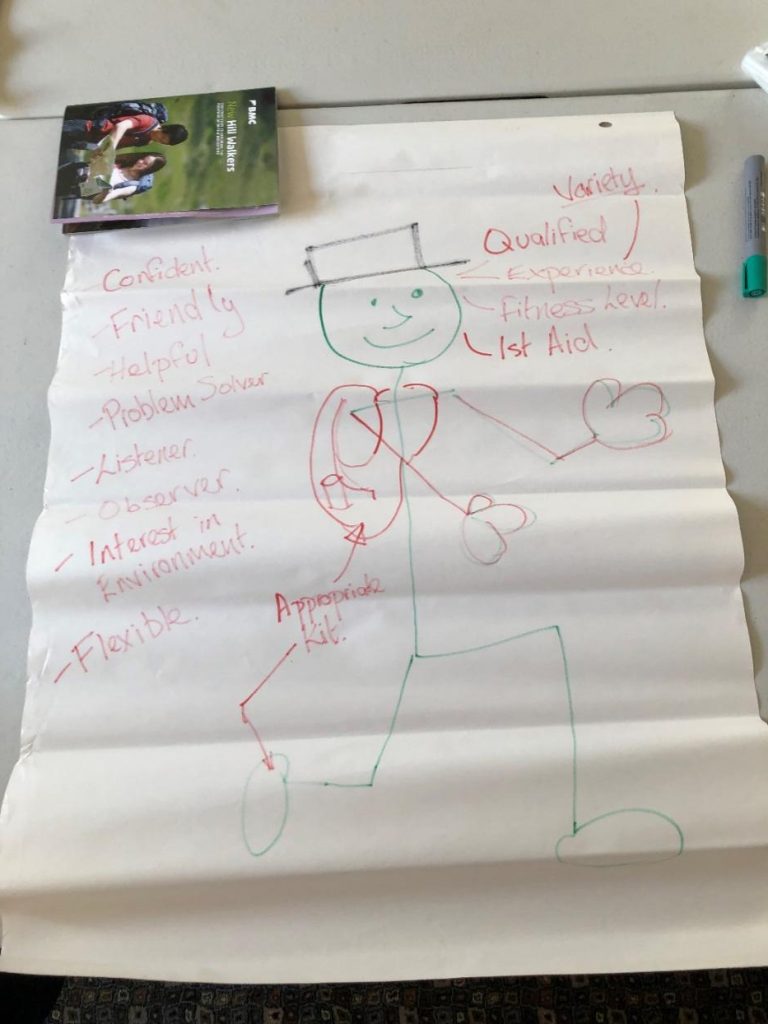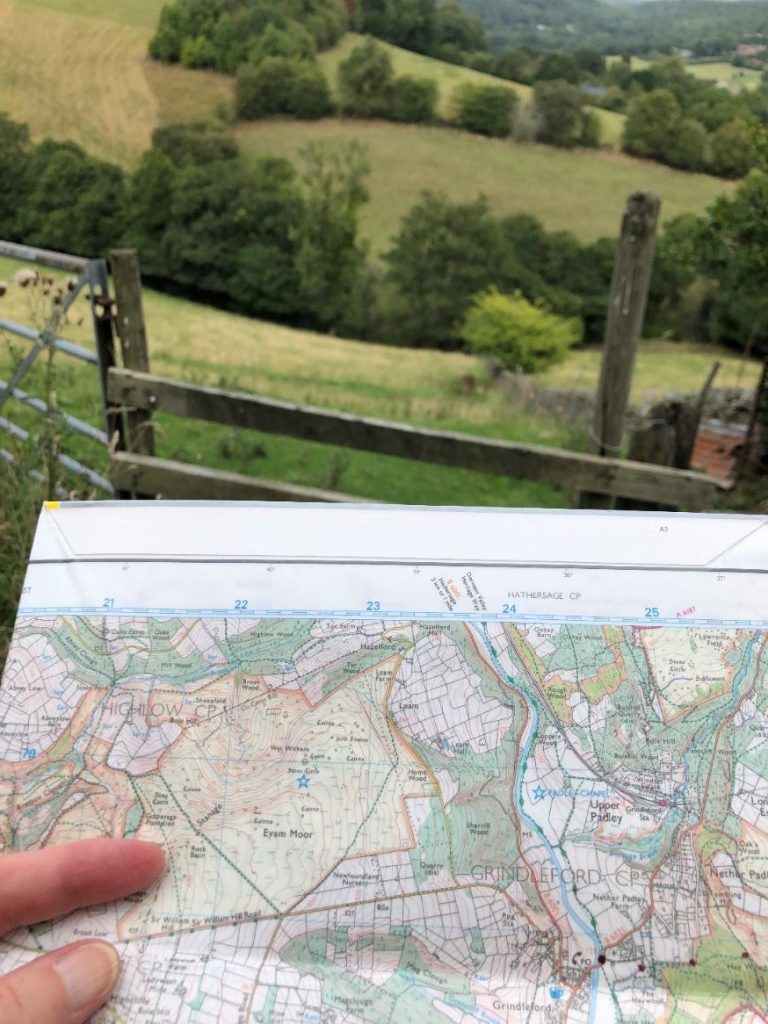Slow Ways pioneering volunteer and artist, Lynn Jackson, has many, many Slow Ways miles under her belt, not to mention other useful input, like this piece of hers on how to get surveying Slow Ways, and this lovely sideline in illustrating the routes she walks. She decided to put herself through the Lowland Leader training course, and since then has led a very successful walk as part of our Leicester swarm weekend. If you think a walk-leading qualification might be for you, scroll on to read about Lynn’s experiences.
“I’ve been reviewing Slow Ways routes for over a year now, and I love doing it. Even my fear of maps and compasses has gone, but I still find myself ‘temporarily misplaced’ enough to know that I need instruction on how to navigate better.
I’d also like to take people out on verified routes and pass on my joy of learning the Slow Ways paths around my area that were there before the age of the motor car.
So, I needed training, and maybe something that leads to a qualification to show that I’m capable of safely leading a group on a Slow Ways route. A quick Google showed that there was such a course – the Lowland Leader training course from Mountain Training.
The Lowland Leader course is for people who wish to lead groups on day walks in lowland countryside and woodland in summer conditions, and sounds as if it could have been designed with most Slow Ways routes in mind. Essentially, the walks must follow known paths, generally be no more than 3km from key access points and must use recognised crossing points for rivers and streams.
After some research, I settled on Beyond the Edge as my training provider as they have a great reputation and are based in the Peak District (a favourite stomping ground of mine).
Day one found me in Grindleford at the front of the Sir William Hotel where the course is based. I met up with the other attendees and our instructor Chris.
After coffee and introductions, Chris set us our first task – drawing a Lowland Leader and listing the skills and qualities that make a good leader. Fortunately my team was happy with my stick man, and we wrote down our version (although I was later persuaded that a top hat might be better left at home…).

And so, our training began. Chris gave a background of the organisations involved in outdoor activities. The British Mountaineering Council is the national representative body for England and Wales that exists to protect the freedoms and promote the interests of hill walkers, not just climbers and mountaineers.
“The ethos of the Lowland Leader is to enthuse, inform and entertain; while knowing where you are and protecting those you are with”
We also looked at the various qualifications and where Lowland Leaders are placed on that map. The ethos of the Lowland Leader is to enthuse, inform and entertain; while knowing where you are and protecting those you are with. I began to feel that we’d missed juggling balls off our stick Leader picture.
Getting outside, and realising I’m terrible at estimating distance!
After lunch we were outside with our rucksacks, maps, and compasses where I demonstrated my woeful lack of distance perception by estimating 3km to a field 750 metres away. Never fear, said Chris, it all comes with practice.
Navigating begins with the three Ds – direction, distance, and description. This is when Chris got Very Specific, stepping through each feature on the map, describing in detail how we were going to get from A to B.
The afternoon gave us the opportunity to use our maps and compasses properly, to take bearings and pace out distances. Throughout this, Chris showed us aspects of the woodland we were in and the animals we could see (and not see) there.
When we got back to the classroom we did route-planning work, considering the type of walking suitable to different groups from children to ladies-who-lunch. This is just as well as I had to plan a walk for nine lads on a stag day for my homework that evening.
Day two and we were joined by trainee instructor Rich to review our homework route plans. Things then got serious as this is an industry qualification. Chris took us through commercial considerations and legal responsibilities of the activity provider and the individual leader, particularly regarding insurance. This wasn’t to scare us however; it’s about proper preparation, risk assessment and management.
To lighten the mood, we then discussed learning about the environment you’re in, as entertainment makes the walk special for those involved. Many things can be used to provide information, from geology to natural history to social history. We learned about the Field Studies Council, which provides online learning.
Leading our first (bit of a) walk
With all this information in our heads, it was time to put things into practice. We planned a route for the afternoon’s walk before striding out into the sunshine. Each of us took a turn leading a section of the walk. We navigated and explained a few things about the area that we’d picked up before the course (we’d been asked to present something in the course-joining instructions). We also took care of Mildred – a nervous new walker looking suspiciously like Chris.

This walk simulated an assessment with the bonus of Chris and Rich guiding and advising us as we led.
Once back in the classroom, we rounded off the course with a session on emergency procedures – who to call and what to do while you’re waiting for them to arrive.
And with that, we had completed our Lowland Leader training course. Chris told us what we needed to do to consolidate our skills (not much for our group, more quality walking days and party management) and explained that we need to attend a 16-hour first aid course before the assessment can be signed off.
I had a great two days of learning and meeting new friends. I’ve come away with a useful set of skills and knowledge that I hadn’t realised was missing from my lowland walking experience and would like to thank my fellow attendees, Chris, Rich and all at Beyond the Edge for making the course as entertaining as it was informative. I am enthused to carry on with my Lowland Leader journey!
For those of you keen to improve your walking skills without the Leader part, the National Navigation Award Scheme has courses where you can learn navigation skills and gain confidence to get out and enjoy the countryside. And Mountain Training has courses for those people wanting improve their hill and mountain walking skills too.”
- Ready to start surveying Slow Ways? Lynn has some surveying tips for you here
- Check out Lynn’s lovely illustrations in this article. Spoiler: the stick man isn’t her finest work…